IAC News
IAC News No.41, March 2016
Japan Society of Civil Engineers International Activities Center March. 1, 2016 IAC News No.41
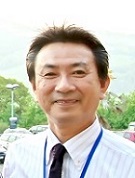
Prof. Eiichi Nakakita (Kyoto University)
Chair of the Committee on Hydroscience and Hydraulic Engineering
Introduction of the Committee on Hydroscience and Hydraulic Engineering
The predecessor of the present committee of hydro engineering is the investigation committee for hydraulics formulary. The committee was established in 1940 as the second investigation committee of Japan Society of Civil Engineers. The committee, however, was once dissolved in 1942 after the publication of the formulary. The committee was reorganized in 1946 and became a standing committee named “Committee of Hydraulics” after publishing the first copy of the hydraulics formulary in 1949. In 1955, Coastal Engineering Committee became an independent committee, but the range of target issues has become wider and wider as time goes by. Therefore, the name was changed to “Committee on Hydroscience and Hydraulic Engineering” in 2003. Research activities, surveys and publications about river or water resource are conducted by the above committee, 4 sub-divisions by field and interdisciplinary meetings. Some activities are introduced below.
◆Conference on Hydraulic Engineering
In 1956, 22 papers were presented in a conference of hydraulic research society. The conference was held at Public Works Research Institute and was the 1st Conference on Hydraulic Engineering. After then, variety of hydro engineering topics have been introduced and discussed, but data on rivers, the revolution of measuring and analysis techniques and the improvement of research environments have diversified research targets year by year. After the 42nd conference was held at Tottori University, the conference is often held in several prefectures. In March 2015, the 59th conference was held in Waseda University. 249 articles were selected from 317 submitted papers by 206 reviewers including 62 editorial committee members.
◆Symposium of Advances in River Engineering
Symposium of Advances in River Engineering aims to develop and spread river engineering techniques through research presentations and panel discussions on river related issues. Therefore, cooperation among public agencies, universities and private companies, pioneering interdisciplinary fields and activities in actual fields is important. In June 2015, the 21st symposium was held in the University of Tokyo as usual. Presentations and discussions were carried out with 499 participants. A journal named “Advances in River Engineering” was also published.
◆Water Symposium
Citizens, private companies, public agencies and Japan Society of Civil Engineers exchange opinions on benefits and problems of water for human beings or nature in order to propose “Suitable relationship between water and human.” The 1st Water Symposium was held in Tottori Prefecture in 1996 and the 20th one was held in Fukui Prefecture in August 2015. Keynote speeches, panel discussions and presentations by children were carried out and 550 participants joined.
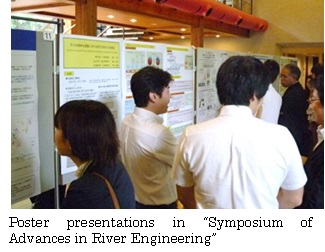 |
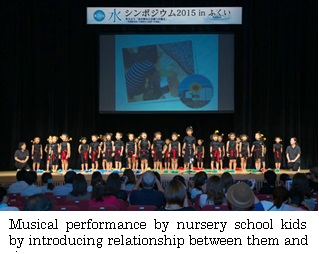 |
Report on “River Technologies for Innovations and Social Systems” –Examples in disaster mitigation and environmental conservation– In conjunction with the 9th Joint International Symposium on Disaster Risk Management.
An international symposium on “River Technologies for Innovations and Social Systems” (hereafter, “River Technology”) attended by approximately 100 participants, was organized by the River Technology Organizing Committee, in collaboration with the WFEO-CDRM and local engineering organizations (JFES, JRRN, JSCE, and AIJ), supported by Japanese government agencies and Asian regional organizations (SCJ, Japan MLIT, and ARRN) on November 28, 2015 from 9:00–18:00 in Kyoto, Japan, prior to the 2015 World Engineering Conference and Convention (WECC 2015). This symposium comprised opening and closing sessions, three sessions covering river/watershed disaster mitigation, environmental conservation, and a panel discussion to enhance information exchange and public awareness of river technologies worldwide. The 10 guest speakers, whose backgrounds were related to disaster mitigation, river engineering, international collaboration, experts consultation with policy makers in regional and municipal governments, including a CEO of a ferry and resort complex management company, gave presentations followed by meaningful Q&A sessions.
In the opening session, the organizing committee chair and representatives of the collaborators and sponsors addressed the purposes and meanings of river technology. In the first session, Dr. Isobe (President, Kochi Univ. of Technology) delivered a keynote lecture on improved coastal zone planning to reduce the effects of tsunami disasters. Next, Dr. Mimura (Deputy Director General, JICA) talked about the implementation of Japanese practices related to flood management and water utilization in developing countries to achieve the UN-Sustainable Development Goals (SDG). The third presenter, Dr. Tsukahara (Prof., Kyushu Univ.), introduced an empirical study on the effect of investments to mitigate flood and sediment disasters in Japan. Dr. Chavoshian (Director, Iran UNESCO Regional Centre) then reported on the current state of a salt lake in the arid and semi-arid West-Asian region under climate change. Finally Dr. Lai (Senior Researcher, Taiwan National Cheng-Kung Univ.) talked about deep-seated severe-typhoon-induced landslides and flood disasters, and the development of an early warning system in Taiwan. The second session was composed of five presentations. Mr. Stroeks (Senior Advisor, Embassy of Netherlands) reported on the Netherlands’ delta program for extreme weather under climate change and the utilization of hydropower. Dr. Tsuchiya (Secretary General, JRRN) then talked about the utilization and conservation of rivers in the modern age in Tokyo over approximately 150 years, including the management of landfills of disaster debris following the Great Kanto Earthquake and air strikes during the World War II. Following this, Dr. Jang (Prof., South Korea Daejin Univ.) talked about a flood control plan in the Seoul metropolitan area, focusing on the conservation of river aquatic systems. Dr. Wu (Deputy Mayor, Kaohsiung city, Taiwan) then reported on practical transformation in Kaohsiung, Taiwan, with a focus on greenery and water. Finally, Mrs. Pichaironarongsongkram (Chair, Chao-Phraya Express Boat, Thailand) discussed water transportation and its historical development along the Chao-Phraya River.
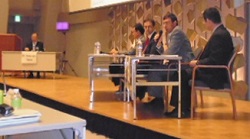 Panel discussion |
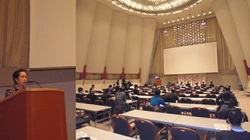 Presenter and the audience |
The panel discussion in the third session led by Dr. Tamai (Chair, River Technology) including four other panelists, was based on the presentations delivered in the prior sessions. They discussed the innovative river technologies and concepts that could mitigate the severe impacts of climate change and maintain river biodiversity. Finally, Dr. Tamai proposed a new concept in the field of river technology that merged two challenging issues, namely risk management for severe floods and environmental conservation for river aquatic systems. A committee member gave a closing address at the end of the symposium. The material presented in the symposium can be viewed at http://river-innovation.net/index_en.html.
(Note) The organizing committee for “River Technologies for Innovations and Social Systems” has the copyright for these photos.
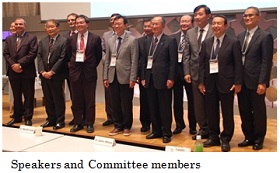
|
【Acronyms】 |
【Nobuaki Kimura, WFEO-CDRM Deputy Secretary (Kyushu University)】
IEB-JSCE Joint Seminar on Advances Bridge Engineering
A joint seminar on bridge engineering between The Institute of Engineering, Bangladesh (IEB) and Japan Society of Civil Engineers (JSCE) convened on 22 August 2015, at Dhaka in Bangladesh. Selected 12 papers were presented, and about 80 professional engineers, researchers, and students participated in the seminar. From the JSCE party, researches on the steel-concrete composite truss bridges and steel box girder bridges, were introduced, which will be constructed in Bangladesh in the immediate future,
This joint seminar was held as part of organized sessions in the IABSE-JSCE Joint Conference on Advances Bridge Engineering-III (ABE-III) being held in parallel on 21 and 22 August. The ABE-III is a joint conference between the International Association for Bridge and Structural Engineering (IABSE) Bangladesh group and JSCE on bridge engineering. The conference was organized to
cerebrate the centenary of the Hardinge Bridge, which is a 100-years-old railway bridge recovered from damages during the liberation war in 1971. With that as a backdrop, the theme of joint seminar was selected as “Towards Owning a Resilience Infrastructure”.
Ministers of Finance, Railway, Science and Technology of Bangladesh Government graced the opening and closing ceremonies of the conference. Mr. Sasahara of the first secretary of Embassy of Japan in Bangladesh and Mr. Toyama of JICA Bangladesh office attended as guest speakers. Emeritus Prof. Nagai of Nagaoka University of Technology, Prof. Ueda of Hokkaido University, and Dr. Kasuga of Sumitomo Mitsui Construction Company delivered keynote addresses. The joint seminar, which attracted 334 participants over 11 countries, was concluded with great success.
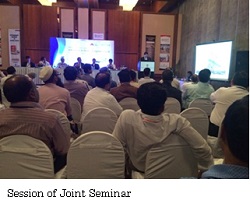 |
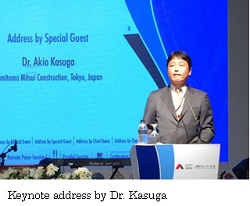 |
【Prof. Yoshiaki Okui, Chair of the Committee on Hybrid Structures (Saitama University)】
What's Happening
- 2016/3/21-22 The 2nd MES-JSCE Joint Symposium (Yangon, Myanmar)
- 2016/3/25-27 Asian Civil Engineering Coordinating Council (ACECC) 30th Executive Committee Meeting (ECM) (New Delhi, India)
Updates
- The summary of feature articles in the JSCE Magazine is available on the JSCE website.
http://www.jsce-int.org/pub/magazine - Concrete Committee International Newsletter No. 43
http://www.jsce.or.jp/committee/concrete/e/newsletter/Newsletter.htm - Journal of JSCE
The Journal of JSCE is the collection of research papers which can be viewed on the JSCE website.
https://www.jstage.jst.go.jp/browse/journalofjsce - Disaster Fact Sheet
http://committees.jsce.or.jp/disaster/ - IAC Students and Alumni Network
http://www.jsce-int.org/IAC_network
IAC News Subscription
The IAC News is one of the communication tools to share information and ideas with the members. We would like to invite you, your friends and colleagues to join the communication and to subscribe the IAC News. Please register online: (http://www.jsce-int.org/pub/registration/non-international_students). We look forward to meeting you.
Editor's postscript
This is the last issue of the International Center News in the academic year 2015. How have you spent the academic year 2015? I feel that time flies faster as I get older. March is very near and literally time flies like an arrow. From April in the new academic year, I would like to actively challenge new research and technological development while keeping in mind that ‘youthful years pass quickly before one accomplishes much learning.’(H.I.)

